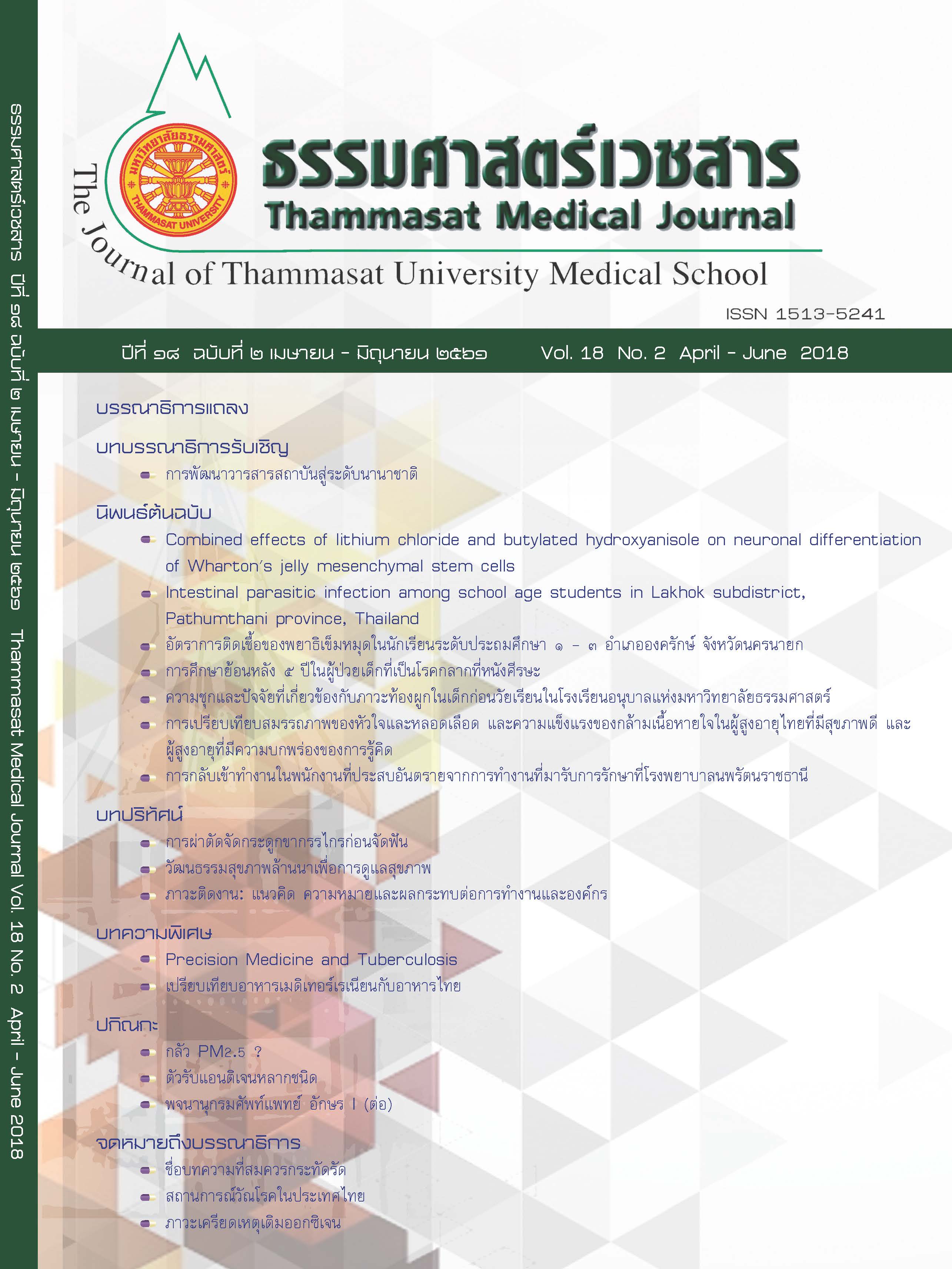การศึกษาการติดเชื้อปรสิตในลำไส้ในนักเรียน ตำบลหลักหก อำเภอเมือง จังหวัดปทุมธานี
คำสำคัญ:
ปรสิตในลำไส้, นักเรียนประถมศึกษา, Simple direct smear, Scotch tape techniqueบทคัดย่อ
บทนำ: เชื้อปรสิตในลำไส้เป็นปัญหาสุขภาพที่ควรเฝ้าระวังโดยเฉพาะอย่างยิ่งในเด็กอายุต่ำกว่า ๑๓ ปี เนื่องจากยังขาดการป้องกันตนเองที่ดีพอ ซึ่งอาจจะทำให้เกิดพยาธิสภาพที่รุนแรงกว่าในผู้ใหญ่ การศึกษาในครั้งนี้มีวัตถุประสงค์เพื่อสำรวจหาความชุกของการติดเชื้อปรสิตในลำไส้ทั้งโปรโตซัวและพยาธิชนิดต่างๆ ในเด็กนักเรียนทุกระดับชั้นของโรงเรียนประถมศึกษา ในตำบลหลักหก อำเภอเมือง จังหวัดปทุมธานี ซึ่งเด็กส่วนใหญ่อาศัยอยู่ในชุมชนริมคลองเปรมประชากรที่ไม่สะอาด เต็มไปด้วยขยะและน้ำเสีย ทำให้มีโอกาสเสี่ยงต่อการติดเชื้อปรสิตชนิดต่างๆ ได้ง่าย
วิธีการศึกษา: เป็นการศึกษาเชิงพรรณนา ณ จุดเวลาใดเวลาหนึ่ง โดยทำการเก็บตัวอย่างอุจจาระจากเด็กนักเรียนทุกระดับชั้นตั้งแต่อนุบาล ๑ จนถึงประถมศึกษาปีที่ ๖ อายุตั้งแต่ ๔ ถึง ๑๒ ปี จำนวน ๙๖ คน โดยเป็นนักเรียนหญิง ๕๑ คน และนักเรียนชาย ๔๕ คน ในช่วงเดือนกรกฎาคม พ.ศ. ๒๕๖๐ ทำการตรวจหาปรสิตลำไส้ในอุจจาระโดยใช้วิธีมาตรฐานคือ simple direct smear ในน้ำเกลือ (0.85% NaCl) และ Lugol’s iodine รวมทั้งวิธีเข้มข้นด้วย Mini Parasep® SF (Apacor, England) ส่วนการตรวจหาพยาธิเข็มหมุดทำโดยวิธี Scotch tape technique วิเคราะห์ผลการตรวจโดยใช้สถิติพรรณนา คือ ความถี่ ร้อยละ
ผลการศึกษา: ผลการตรวจอุจจาระ พบปรสิตในลำไส้ร้อยละ ๒๐.๘๓ ซึ่งส่วนใหญ่เป็นเชื้อโปรโตซัว โดยพบในเพศหญิงสูงกว่าเพศชาย (ร้อยละ ๒๕.๔๙ และ ๑๕.๕๖ ตามลำดับ) โดยปรสิตที่พบเป็นปรสิตที่ไม่ก่อโรคร้อยละ ๑๕.๖๒ และปรสิตก่อโรคร้อยละ ๕.๒๑ ชนิดของปรสิตที่พบสูงสุดคือ Blastocystis spp. (ร้อยละ ๖๕ ของปรสิตทั้งหมดที่พบ) ซึ่งในจำนวนนี้พบมากกว่า ๕ เซลล์/HPF อยู่ร้อยละ ๑๐ นอกจากนั้นยังพบปรสิตก่อโรคคือ Giardia lamblia ร้อยละ ๑๐ และไข่ของพยาธิเข็มหมุด (Enterobius vermicularis) ร้อยละ ๕ อีกด้วย สำหรับผลการตรวจหาพยาธิเข็มหมุด ด้วยวิธี Scotch tape technique พบการติดเชื้อพยาธิเข็มหมุดร้อยละ ๕.๔๑ โดยพบในเด็กชายมากกว่าเด็กหญิง (ร้อยละ ๗.๕๐ และ ๒.๙๔ ตามลำดับ)
วิจารณ์และสรุปผลการศึกษา: จากผลการศึกษาในครั้งนี้ พบการติดเชื้อปรสิตลำไส้สูงกว่าการศึกษาที่ผ่านมา และสูงกว่าค่าเฉลี่ยของทั้งประเทศ แม้ปรสิตที่พบส่วนใหญ่จะไม่ก่อโรค แต่ก็เป็นปรสิตที่มักพบปนเปื้อนในอาหารและน้ำดื่มที่ไม่สะอาด ซึ่งเป็นดัชนีบ่งชี้ถึงสุขลักษณะที่ไม่ดีสอดคล้องกับพฤติกรรมการดำรงชีวิตของเด็กที่อาศัยอยู่ในชุมชนโดยรอบโรงเรียน ซึ่งทำให้มีโอกาสติดเชื้อได้มาก โดยข้อมูลนี้จะเป็นข้อมูลเบื้องต้นในการวางแผนการรักษาและสร้างสุขาภิบาลในชุมชนต่อไป



